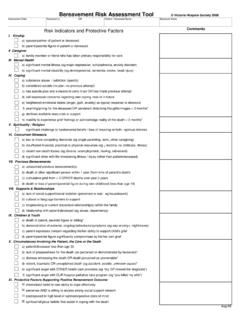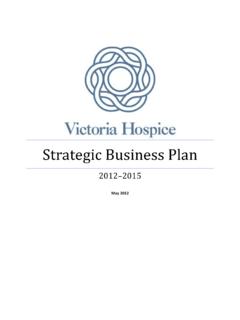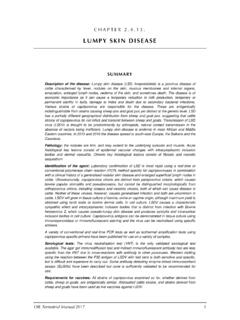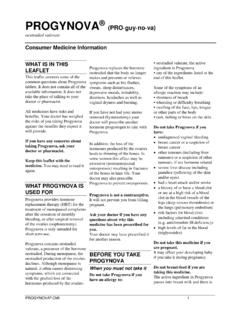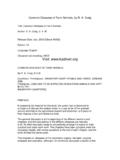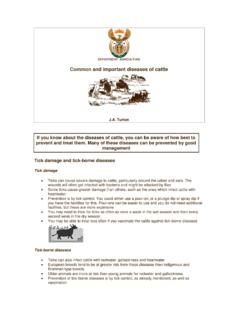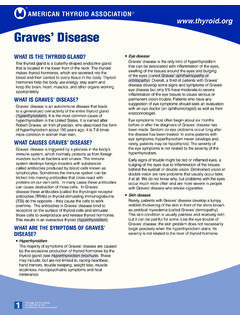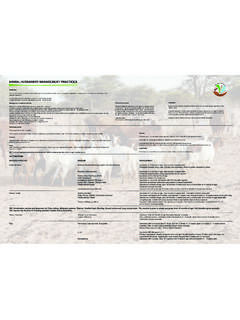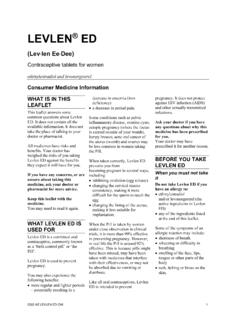Transcription of Bowel Management Guideline - Victoria Hospice
1 Introduction The following Guideline is intended for general advice only. Clinical assessment and judgment is unique for each patient circumstance and, along with informed patient and family discussions, should determine the most appropriate plan of care for the patient. Bowel function is important at all times of life, especially in advanced disease and palliative care. Holmes reported that Bowel problems were the most common symptom distress at 18% compared to tiredness 15%, anorexia 8%, pain 6% and nausea 4%. Upwards of 50% of patients admitted to a Hospice are constipated and, by end-of-life, Bowel dysfunction rises up to 80%. Although constipation is the more common problem, diarrhea also occurs and is sometimes related to treatments such as inadvertent over-use of laxatives due to opioids or adverse effects of cancer radiation, chemotherapy or surgery.
2 Assessment and documentation of Bowel function is often poorly recorded in an ongoing measurable method. This makes monitoring severity and/or alterations in Bowel function difficult to Guideline covers the spectrum between constipation and diarrhea utilizing the Victoria BPS tool and Management Guideline . Although there are other Bowel scales found in the literature, these are mostly specific to either constipation, such as the Constipation Assessment Method (CAS) and Constipation Visual Analogue Scale (CVAS) or diarrhea and are sometimes designed for a specific disease (ulcerative colitis). A patient-rated adjectival VAS scale using (0) worst diarrhea to (10) worst constipation was validated by Nishisato. A visual stool assessment form shows constipation to diarrhea. Assessment can also involve use of abdominal X-rays as done by Bruera et the patient is currently undergoing disease-modifying therapy such as chemotherapy, and where a symptom like diarrhea may be a complication of such treatment, then consultation by the Palliative Care Physician or with the relevant specialist and Family Physician is important to determine the next steps.
3 Emergence of such a complication may be reversible, and thus allow continued active treatment that the patient is seeking, or it may indicate need for change, or even discontinuation, of of Bowel Management GuidelineGoalsTo provide relief of distress resulting from constipation or diarrhea, as acceptable to the patientTo assess patient s Bowel needs through appropriate history, physical and laboratory evaluationTo assess, assist and support families in understanding and coping with issues of Bowel care, including imminently dyingTo develop care plan with and receive orders from the Palliative Care Physician or Family PhysicianTo monitor the effects of Bowel Management and adjust accordingly within care plan Assessment and Investigation (Record assessment results for each category in patient chart)General status functional (PPS); quality of life; patient s hopes, goals, plans; family and home supports; ethical modelDisease Management current active Rx; between Rx cycles; available palliative Rx in reserve; no possible/stopped RxNearness to death stable or changing (if so, reason?)
4 Is constipation or diarrhea prematurely contributing to decline?Use BPS to record relevant scores on each visit at home or daily in the Palliative Care UnitAdditional information about stools may be valuable including Bowel pattern onset ( diarrhea), duration, frequency, timing, aggravating and alleviating factors, stool volume and appearance (consistency, color, odor, blood, mucous), bloating, flatusIntake including amount and type of food and fluids, as well as drugs which may cause diarrhea or constipationPhysical assessment for other possible contributing factors such as Bowel obstruction, hemorrhoids, fistula, anal fissureEvidence of under-hydration if diarrhea is present: severe thirst; dry mouth; minimal/no intake; poor tissue turgorPossible lab investigation including stool cultures and other tests; BUN, Creatinine; electrolytes.
5 CBCR eview possible and likely causes for constipation (Table AH 2) or diarrhea (Tables AH 3, AH 4) based on individual situation TreatmentInvestigations and treatments likely to improve function, as desired by patient, should be undertakenA wide range of possible treatments exist for both constipation and diarrheaGeneral patient status, intake, overall current disease Management plan and nearness to death are important considerations in determining the optimum treatments for each patient Attend to other factors such as pain, nausea, vomiting, hemorrhoids, etc. which may contributeHydration may be appropriate in cases of severe diarrhea (see VHS Hydration and Hypodermoclysis Guideline )Determine and arrange optimum location for care based on etiology and Rx plans home, palliative unit, hospital ward, outpatient clinic Bowel Management GuidelineVictoria HospiceVictoria Bowel Performance Scale.
6 Medical Care of the Dying, 4th ed.; p. 343. Victoria Hospice Society, 4- 3- 2 - 1 BPS Score0+ 1+ 2+ 3+ 4 ConstipationNormalDiarrhea Impacted or Obstructed+/- small leakageFormedHard with pelletsFormedHardFormed SolidCharacteristicsFormedSoftUnformedLo ose or paste-likeUnformedLiquid mucousUnformedLiquid mucousFormedSemi-solidNo stool producedDelayed 3 daysDelayed 3 daysPatient s UsualPatternPatient s UsualUsual or FrequentFrequentFrequent Patient s UsualUnable to defecate despite maximum effort or strainingMajor effort or strain-ing required to defecateModerate effort or strain-ing required to defecateMinimal or no effort required to defecateControlMinimal or no effort required to con-trol urgencyModerate effort required to control urgencyVery difficult to control urgency and may be explosiveIncontinent or explosive;unable to control or unawareMinimal or no ef-fort to defecateCohen s kappa ; Abs Agree ICC [95% CI] (p= ) Downing, Watson, Carter Victoria Hospice SocietyInstructions for Use1.
7 BPS is a 9-point numerical scale. It is a single score, based on the overall best vertical fit among the above three parameters [characteristics, pattern, control] and is recorded for exam-ple as: BPS +1, BPS -3 or BPS +22. Look vertically down each BPS level to become familiar with how the three parameters of characteristics, pattern and control change in gradation from constipation to diarrhea3. The usual Bowel pattern for a patient may be in the 0, -1 or +1 columns. For any of these, the actual frequency of Bowel movements may vary among patients from one or more times daily to once every 1-2 days but the patient states that this is their usual pattern4. Patients with a surgical intervention (colostomy, ileostomy, short loop Bowel ) may have a more frequent usual Bowel pattern than above. BPS is still overall graded by combining all three parameters ( +2 or +3 with ileostomy) to ascertain a best fit 5.
8 Patients may use different words than above to describe their Bowel activity. One must use clinical judgment in deciding which boxes are most appropriate6. In potential confounding cases, determination of the most appropriate BPS score is made using the following methods: Two vertically similar parameters generally outweigh the third; Single priority weighting among parameters is Characteristics > Pattern > ControlBPS Case ExamplesExample OneA 62-year-old male has metastatic Ca prostate. His PPS is 40% and ECOG performance status is 3. He currently takes hydromorphone, colace and senokot. His Bowel movements have been regular, but today he states he had two mushy stools this morning and I had to go right away. His BPS is rated at BPS +2. Although his Bowel pattern has been usual, today frequency increased to twice. Looking at the scale, this probably fits best with the usual or frequent box.
9 The stool character is mushy and most resembles the unformed, loose or paste-like box. Finally, there was some effort required to control his bowels since he noted having to get to the bathroom right away. This could indicate either the +1 box [minimal or no effort to control] or the +2 box [moderate effort required to control]. Taking all three parameters into account, the best overall vertical fit would fall at the BPS +2 TwoA 78-year-old female has metastatic Ca breast. She is quite active at PPS 70% and ECOG 2 but, with increasing pain in her back, she has required higher doses of long-acting morphine. This has caused Bowel troubles for her and she has gone only twice in the last week. The stool was lumpy and hard and it sometimes hurts to pass a bm. She denies having score is BPS -2. She notes a change from her usual pattern with decreased frequency since twice per week she calls trouble.
10 This pattern fits with either -2 or -3, but not -1 or -4. Also, the stool can be painful to pass which indicates some difficulty in control. It is not clear whether this difficulty requires mild or moderate effort but it does not appear to be a major problem. The stool is characterized as lumpy and hard which means it is both formed and hard and does not seem by the description to be broken up into pellets. The overall best vertical fit is BPS -2. Victoria Bowel Performance Scale (BPS) Victoria HospiceVictoria Bowel Performance Scale. Medical Care of the Dying, 4th ed.; p. 345. Victoria Hospice Society, 4- 3- 2 - 1 BPS Score0+ 1+ 2+ 3+ 4 ConstipationNormalDiarrhea Prior as toleratedPrior as tolerated Increase fluidIncrease fibre as toleratedMaintain usualIntake*Maintain usual? Reduce fibre Reduce fibreAlter solid intakeNo fibreAlter intake to clear fluids Maintain usualLaxatives as priorTrial one of:- Fleet Phospho Soda oral- Citromag- X-Prep?
